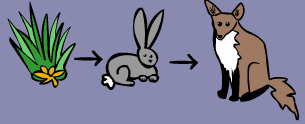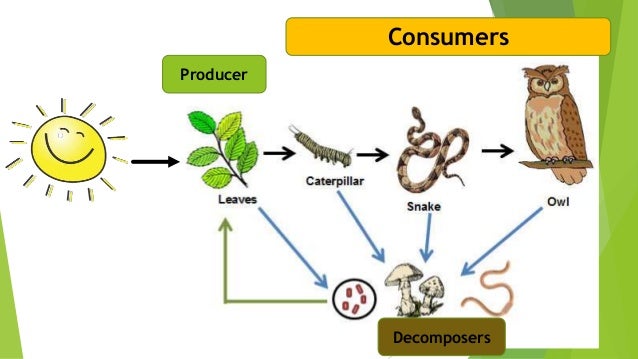
Each ecosystem has its own energy flow. This energy flow includes food chains and food webs.
A food chain shows how each living thing gets food, and how nutrients and energy are passed from organism to organism. Food chains begin with plant-life, and end with animal-life. Some animals eat plants, some animals eat other animals.
A simple food chain could start with grass, which is eaten by rabbits. Then the rabbits are eaten by foxes.

A food web consists of all the food chains in a single ecosystem. Each living thing in an ecosystem is part of multiple food chains. Each food chain is one possible path that energy and nutrients may take as they move through the ecosystem. All of the interconnected and overlapping food chains in an ecosystem make up a food web.

The difference between food chains and food webs is:
Food chains follow a single path as animals eat each other.
Example:
- THE SUN provides food for GRASS
- The GRASS is eaten by a GRASSHOPPER
- The GRASSHOPPER is eaten by a FROG
- The FROG is eaten by a SNAKE
- The SNAKE is eaten by a HAWK.
Food webs show how plants and animals are interconnected by different paths.
Example:
- TREES produce ACORNS which act as food for many MICE and INSECTS.
- Because there are many MICE, WEASELS and SNAKES have food.
- The insects and the acorns also attract BIRDS, SKUNKS, and OPOSSUMS.
- With the SKUNKS, OPPOSUMS, WEASELS and MICE around, HAWKS, FOXES, and OWLS can find food.
They are all connected! Like a spiders web, if one part is removed, it can affect the whole web.
FOOD WEBS show how plants and animals are connected in many ways to help them all survive. FOOD CHAINS follow just one path of energy as animals find food.
Parts of the Food Chain: Producers, Consumers, and Decomposers
The process is called photosynthesis.

Animals are called consumers. This is because they cannot make their own food, so they need to consume (eat) plants and/or animals.
We study 3 groups of consumers.
- Herbivores - Animals that eat only plants.
- Carnivores - Animals that eat only animals.
- Omnivores - Animals that eat both animals AND plants. Humans are also omnivores!

Bacteria and fungi are decomposers. They eat decaying matter - dead plants and animals and in the process they break them down and decompose them. When that happens, they release nutrients and mineral salts back into the soil - which then will be used by plants!

Energy Pyramids
An energy pyramid is a model of energy flow in a community. The different levels represent different groups of organisms that might compose a food chain. From the bottom-up, they are as follows:
Producers — bring energy from nonliving sources into the community
Primary consumers — eat the producers, which makes them herbivores in most communities
Secondary consumers — eat the primary consumers, which makes them carnivores
Tertiary consumers — eat the secondary consumers

An energy pyramid’s shape shows how the amount of useful energy that enters each level — chemical energy in the form of food — decreases as it is used by the organisms in that level.
The consumers at the top of a food pyramid, as a group, have much less energy available to support them than those closer to the bottom. That’s why their numbers are relatively fewer in most communities. Eventually, the amount of useful energy left can’t support another level. That’s why energy flow is depicted in the shape of a pyramid.

Check out these Crash Course Kids Videos:
Gotta Eat!
Fabulous Food Chains
Here are some games to help solidify these concepts:
Food Chain Game
Build a Food Chain
Fun with Food Webs
Food Web Game
Food Web
Fish Food Game
Energy Pyramid
Producer, Consumer, and Decomposer Game


No comments:
Post a Comment